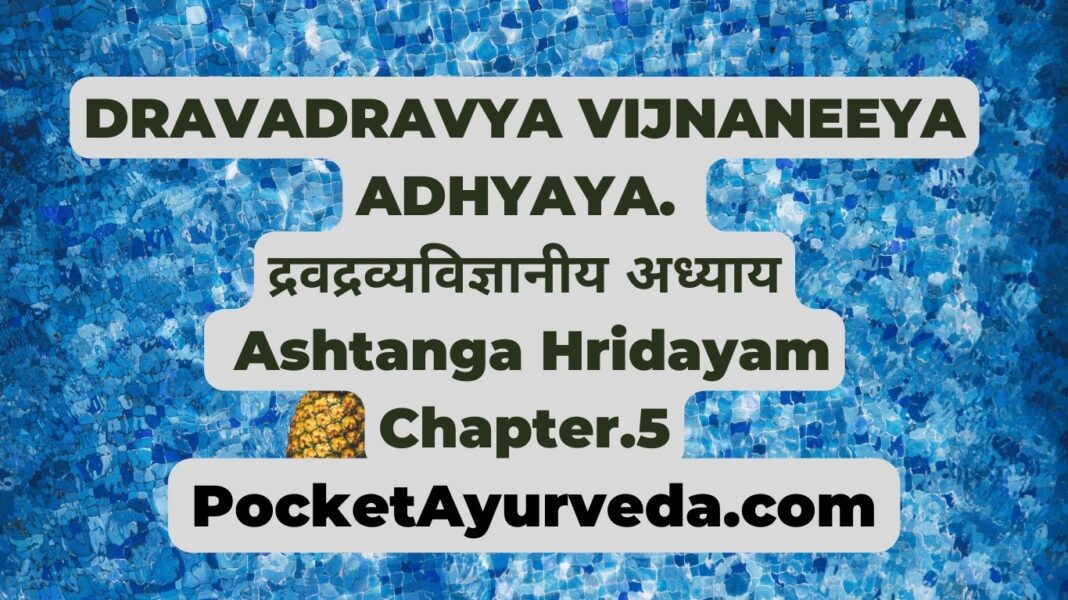The 5th chapter of Ashtanga Hridayam, Sutrasthana, is known as Dravadravya Vijnaneeya Adhyaya. It deals with the types and health benefits of all liquid foods. It details the types and benefits of water, milk, dairy products, sugarcane juices, honey, oils, wines, and urine.
1. TOYA VARGA – GROUP OF WATERS
Benefits of drinking rain water – Gangambu
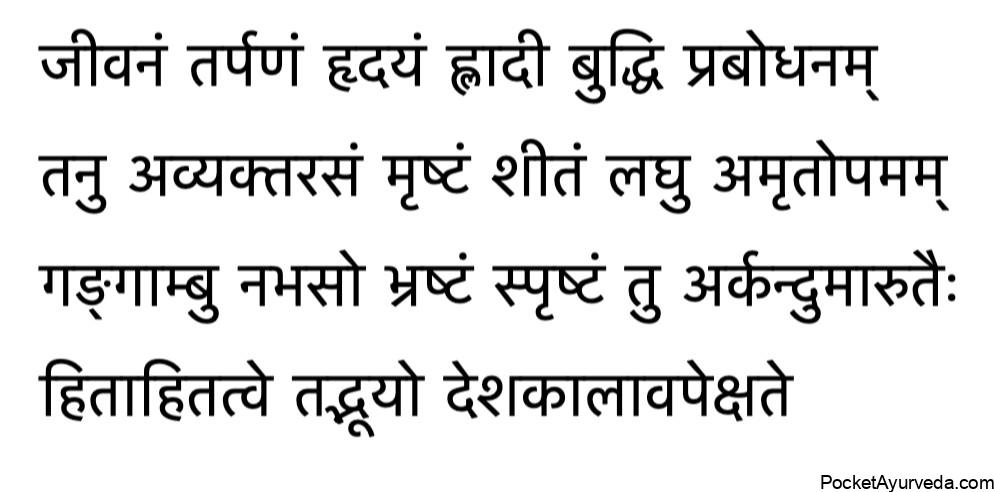

Rainwater is which has come into contact with Sunlight, Moonlight, and the wind is
1. Jeevaneeya – Enlivening, improves the quality of life
2. Tarpana – Nourishing
3. Hrudya – good for the heart
4. Hladi – calming and soothing to the mind and stomach
5. Buddhi prabodhanam – Stimulates intellect
6. Tanu – thin
7. Avyaktarasa – imperceptible taste
8. Sheeta – cold
9. Laghu (light to digest)
10. Amrutopama – similar to nectar
Whether rainwater is good or bad depends on the season and place where it rains.
Notes –
· The properties described above are of rainwater collected in a clean vessel directly, a little while after the commencement of rain.
· It should be consumed within a few hours as it loses its properties.
· With the increasing industrialization and pollution, the rainwater has lost its quality nowadays.
· Hence, may not be good to consume.
How to test water quality


Only that rainwater which makes the boiled rice kept in a clean silver plate neither too moist nor change its color is to consider as good for drinking.
SAMUDRAMDU – SEA WATER QUALITIES


· Seawater should not be used for drinking expect during Ashvayuja month. (September. October/autumn season).
Notes:-
During Ashvayuja month there will be the appearance of Agastya nakshatra (the star Canopus) which is said to remove the poisonous properties of water and other things of the earth, hence permission to use other kinds of water for drinking during this month.
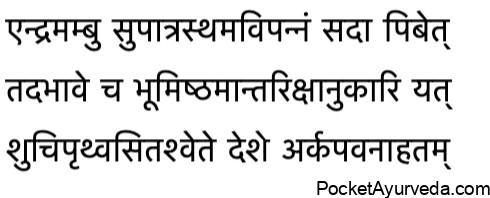

Which Water should be consumed?
1. Rainwater, collected in a clean vessels and
2. which has not changed in color, taste, and odor,
should be used for drinking always.
In its absence,
· the water of the earth, which resembles rainwater in all its qualities,
· collected from a clean vast place that has black or white soil,
· which is exposed to sunlight and breeze.
CONTAMINATED WATER – DUSHTAJALA
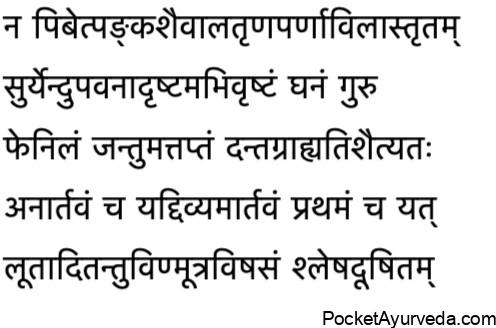

Water which is
1. dirty,
2. mixed with mud, algae, weeds, and leaves,
3. which is not exposed to sunlight and wind,
4. which is a mixture of old and fresh,
5. which is thick,
6. not easily digestible,
7. frothy,
8. containing worms,
9. hot (by nature),
10. causes tingling of teeth by being very cold,
11. that rainwater which is un-seasonal or
12. though seasonal that of the first rain (before the appearance of Agastya Nakshatra,
13. that contaminated with the webs, saliva, urine, faeces of spider etc., and such other poisonous materials,
should not be used for drinking.
RIVER WATER BENEFITS – NADIJALA


· water of the rivers which flow into the western ocean (Arabian sea),
· which are sweet and
· which have pure water (uncontaminated)
is good for health,
· whereas that flowing into eastern ocean
is not ideal for consumption.
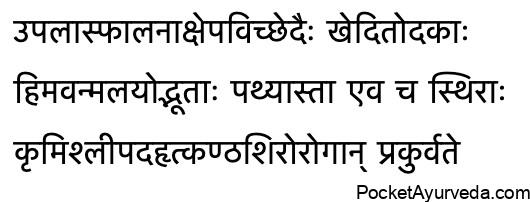

a. The water of rivers arising from Himalaya and Malaya mountains,
b. and which get churned up well by dashing against rocks
are good for health,
Whereas the same water
· If gets stagnated (and gets contaminated)
gives rise to
Contaminated water diseases
a. worms (intestinal parasites),
b. filariasis,
c. diseases of the heart,
d. throat and
e. head.
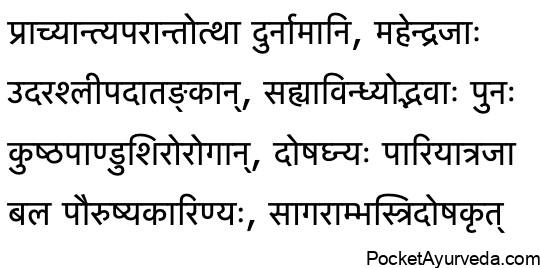

Diseases from river water
a. Water of rivers of the Prachya(gauda), Avanti(malwa) Aparanta (konkana) countries
· causes hemorrhoids.
Pracya or Gauda desa comprises central Bengal and parts of Orissa.
Avanti or Malwa country was round about the modern city of Ujjain.
Aparanta or konkana comprises of goa, karwar and north kanara districts of Karnataka.
b. Water of rivers arising from Mahendra mountains cause
· enlargement of the abdomen and
· filariasis;
Mahendra mountain is the northern part of the eastern ghats, (the whole range of hills extending from Orissa to the district of Madura was known by the western Ghats.)
c. those arising from Sahya and Vindhya mountains causes
· leprosy (and other skin disease)
· anaemia and
· diseases of the head
Vindhyas are mountain ranges of central India.
d. of those arising from Pariyatra
· mitigate the (aggravated) dosas,
· bestow strength and
· sexual vigour,
Pariyatra is the western part of the Vindhya mountains.
e. the water of the sea
· causes vitiation of all three dosas.
विद्यात्कूपतडाकादीन् जाङ्गलानूपशैलतः
The water of kupa (deep well), tadaga (artificial pond), etc., should be considered to be similar (in qualities and properties ) to those of the desert, marshy, and mountains (respectively).
JALAPANA VARJA- AVOIDING OF DRINKING WATER
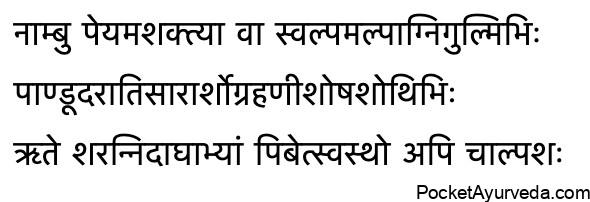

Water
1. should not be consumed or consumed in very little quantity,
2. by those suffering from poor digestive function,
3. tumors of the abdomen,
4. anaemia,
5. enlargement of the abdomen,
6. diarrhoea,
7. haemorrhoids,
8. diseases of the duodenum,
9. dropsy.
10. Excepting for Sharad (autumn) and Nidagha (summer) even healthy persons should drink less quantity of water
in all other seasons


When to drink water with food?
a. Drinking water in between meals – a healthy habit.
b. Drinking water after meals – causes obesity
c. Drinking water before meals – causes emaciation, weakness
COLD WATER BENEFITS – SHEETAJALA


Cold water relieves
1. Madatyaya – alcoholic intoxication,
2. Glani – exhaustion,
3. Murcha – fainting,
4. Chardi – vomiting,
5. Shrama – debility (fatigue),
6. Bhrama – dizziness, giddiness,
7. Trushna – thirst,
8. Ushna – heat (of the sun) burning sensation,
9. Pittasra – bleeding conditions and Pitta dominant conditions
10. and Visha – poison.
DRINKING HOT WATER BENEFITS – USHNAJALA
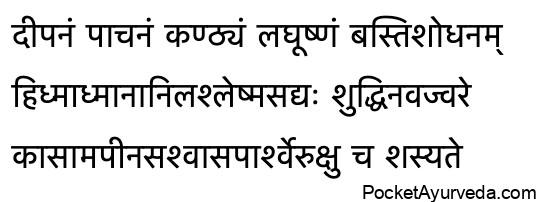

Hot water
1. Deepana – stimulates hunger,
2. Pachana – helps digestion,
3. Kantya – good for the throat,
4. Laghu – easily to digest,
5. Basti shodhana – cleanses the urinary bladder,
Relieves
6. Hidhma – relives hiccup,
7. Adhmana – flatulence,
8. Anila – aggravation of Vata
9. Shleshma – aggravation of Kapha
10. It is ideal on the days of Panchakarma therapy
11.Navajvara – fever of recent origin
12. Kasa – cold, cough
13. Ama – accumulation of undigested materials,
14. Peenasa – rhinitis (running nose),
15. Shwasa – dyspnoea and
16. Parshvaruja – pain in the flanks
अनभिष्यन्दि लघु च तोयं क्वाथेतशीतलम्
पित्तयुक्ते हितं दोषे, व्युषितं तत्रिदोषकृत्
Water which is boiled and then cooled
a. Anabhishyandi – does not increase moisture or stickiness in the body
b. Laghu – light to digest
c. Useful in Pitta conditions
Water that is kept overnight,
a. is not ideal for consumption.
b. It increases Tridosha.
COCONUT WATER BENEFITS – NARIKELODAKA


Tender coconut water is
1. Snigdha
2. Swadu – sweet,
3. Vrushya – aphrodisiac,
4. Hima – coolant,
5. Laghu – easy to digest
Relieves
a. Trushna – thirst,
b. Pittanila hara – balances Pitta and Vata.
c. Deepana – increases hunger and
d. Bastishodhana – cleanses urinary bladder.


Which water should be consumed during rainy season?
During varsa (rainy season)
a. rainwater is best and
b. river water least suitable for consumption.
KSHEERA VARGA – GROUP OF MILK AND MILK PRODUCTS
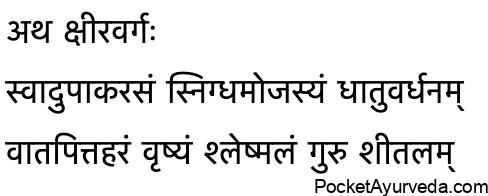

Qualities of milk
1. Svadupakarasa – sweet in taste and also at the end of digestion,
2. Snigdha – unctuous,
3. Ojovardhana – increases Ojus,
4. Dhatuvardhana – nourishes and increases body tissues,
5. Vata Pittahara – mitigates Vata and Pitta,
6. Vrushya – aphrodisiac,
7. Shleshmala – increases kapha
8. Guru – heavy to digest
9. Sheetala – coolant
COW MILK BENEFITS – GOKSHEERA
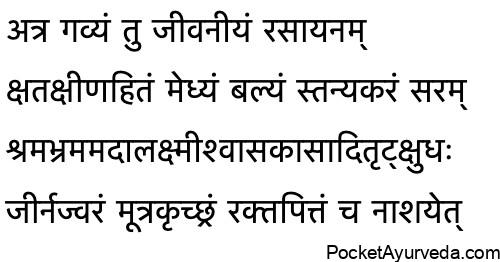

Cow’s milk Qualities
1. Jeevaneeya – promotes long life,
2. Rasayana – anti aging, rejuvenating
3. Kshataksheena hita – good for those emaciated after chest injury
4. Medhya – increases intelligence,
5. Balya – strengthening
6. Stanyakara – promotes breast milk production
7. Sara – helps easy movement of the bowels
Cow’s milk uses
a. Shramahara – exhaustion,
b. Bhramahara – dizziness
c. Mada – toxicity,
d. Alakshmi – in-auspiciousness
e. Shwasa – dyspnoea,
f. Kasa – cough,
g. Atitrut Kshudha – severe thirst and hunger,
h. Jeernajvara – chronic fevers,
i. Mutrakrichra – dysuria
j. Raktapitta – bleeding diseases
BUFFALO MILK BENEFITS – MAHISHA KSHEERA


Buffalo milk is good for
1. people with very good digestion power,
2. who suffer from Anidra – insomnia.
3. It is a coolant.
GOAT MILK BENEFITS – AJA KSHEERA


Goat drinks less water and does a lot of walking. It eats pungent and bitter grass and vegetables, that is light to digest. Hence goat milk also carries these qualities.
Goat milk is useful in
1. Shosha – emaciation
2. Jvara – fever
3. Shwasa – dyspnoea, asthma, chronic bronchial disorders
4. Raktapitta – bleeding disorders of Pitta origin such as hemorrhoids, nasal bleeding
5. Atisara – diarrhoea, dysentery.
CAMEL MILK BENEFITS – USTRA KSHEERA


Ushtra ksheera – Camel milk qualities and uses
1. Ishat ruksha – slightly dry
2. ushna – hot
3. Lavana – salty taste
4. Deepana – increases digestion strength
5. Laghu – easy to digest
6. Vatakaphaan shastam – useful in Vata and Kapha
7. Krumi – relieves worm infestation
8. Shopha – anti inflammatory
9. Udara – useful in ascites
10. Arshas – haemorrhoids.
BREAST MILK BENEFITS – MANUSHA KSHEERA


Breast milk is uses
1. Vata and Pitta imbalance disorders
2. Asruk – blood vitiation disorder
3. Abhighata – useful in injuries
4. Akshirooga – it is used as an eye drops to relieve eye infections and to relieve redness.
It is used in
a. Tarpana and
b. Ashchottana types of eye treatments.
c. It is also used as nasal drop.
AVIKA KSHEERA –Sheep MILK


Eve’s milk
1. is not good for heart,
2. hot in nature,
3. useful in Vata disorders,
4. gives rise to hiccup,
5. respiratory conditions.
6. It increases Pitta and Kapha.
ELEPHANT MILK BENEFITS – HASTIKSHEERA


· It is strengthening in nature.
MILK OF SINGLE HOOFED ANIMALS – EKASHAPHA KSHEERA


Milk of single-hoofed animals (like horse, donkey, etc)
1. is very hot (in potency),
2. useful in vata disorders,
3. is slightly sour and salt and
4. causes lassitude (laziness).
Uncooked milk is always harmful


1. Abhisyandi (causes excess secretion in the tissue pores, causing their blockage)
2. Guru – heavy to digest
3. Amakara – causes Ama and indigestion
4. Yuktya shrutam amrutopamam – if it is properly boiled, it is similar to nectar. Otherwise, it is poison.
5. Dharoshna – Milk drawn from udder (nipple) direct in to mouth is similar to nectar. (provided cow is perfectly healthy without any infection)
CURD BENEFITS/SOURED MILK/COAGULATED MILK – DADHI
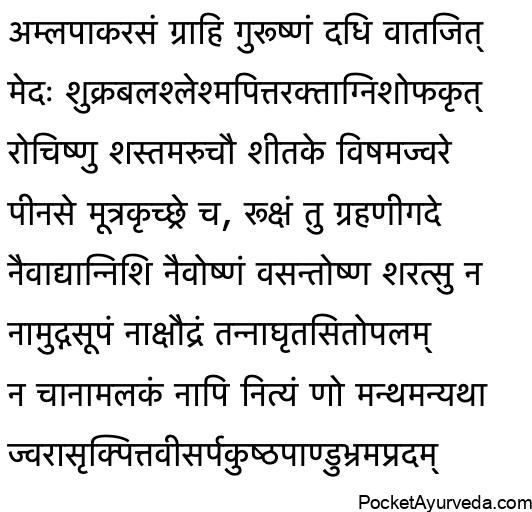

Curd Qualities
1. Amla rasa – sour taste
2. Amla paka – undergoes sour taste conversion after digestion
3. Grahi – absorbent, useful in diarrhea,
4. Guru – heavy to digest
5. Ushna – hot in nature
6. Vatajit – balances Vata
7. Increases
· Meda (fat),
· Shukra (semen),
· Bala (strength),
· Kapha,
· Raktapitta (bleeding disorders),
· Agni (digestion strength) and
· shotha (inflammation).
8. Rochishnu – increases the taste
Dadhi Uses in diseases
· aruchau – useful in anorexia
· Vishamajwara – chronic, recurrent fever
· Peenasa – rhinitis
· Mutrakruchra – dysuria
· Grahani – malabsorption syndrome
Rules for curds consumption / When and How to take Cured as per Ayurveda
a. Curd should not be eaten at night,
b. Not made hot,
c. Curd should not be taken along with green gram soup
d. It should not be taken along with honey, ghee, sugar, and Amla.
e. It should not be taken daily.
What happens when you consume curd daily
· It may cause/worsen fever,
· bleeding disorders,
· skin diseases,
· anemia and
· dizziness.
TAKRA – FAT LESS BUTTERMILK
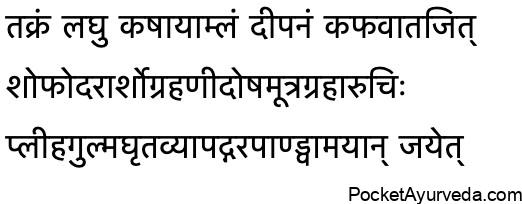

Takra (butter milk) – churned curds Qualities
1. Laghu – easy to digest
2. Kashaya, amla – sour, astringent,
3. Deepana – improves digestion strength
4. Kaphavatajit – balances Kapha and Vata
Takra uses Indications and Benefits
a. Shopha – inflammatory conditions
b. Udara – ascites
c. Arsha – haemorrhoids
d. Grahani – malabsorption syndrome
e. Mutradosha, Mutragraha – urine infection, dysuria
f. Aruchi – anorexia
g. Pleeha – splenomegaly
h. Gulma – abdominal distention
i. Ghritavyapat – in indigestion caused by excess consumption of ghee
j. Gara visha – chronic intoxication and
k. Pandu – anemia
MASTU – SUPERNATENT LIQUID OF CURDS (WHEY/WATERY PART OF CURDS) :-


Mastu is similar to buttermilk.
Qualities of mastu :
· Sara – promotes movement of fluids inside body channels
· Srotashodhi – cleanses body channels
· Vishtambhajit – relieves constipation
· Laghu – easy to digest.
NAVANITA – BUTTER
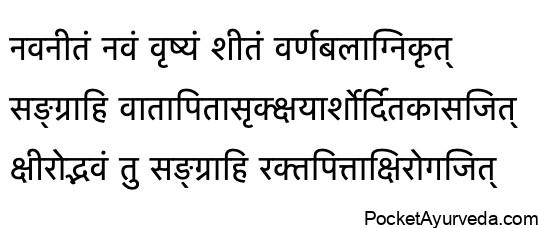

Fresh butter qualities
1. Vrushya – aphrodisiac,
2. Sheeta – coolant
3. Varna, bala, agnikrut – improves skin complexion, strength and digestion strength.
4. Sangrahi – abosrbent, useful in diarrhoea
5. Vatapittasruk jit – balances Vata, Pitta and detoxifies blood
Butter uses and benefits
a. Kshaya – chronic respiratory disorders leading to emaciation
b. Arsha – hemorrhoids
c. Ardita vata – paralysis
d. Kasa – cough
The butter made directly from milk is
i. Sangrahi – absorbent, useful in diarrhoea
ii. Raktapittajit – useful in bleeding disorders
iii. Akshirogajit – useful in eye diseases.
GHEE – GHRITA – CLARIFIED BUTTER :-
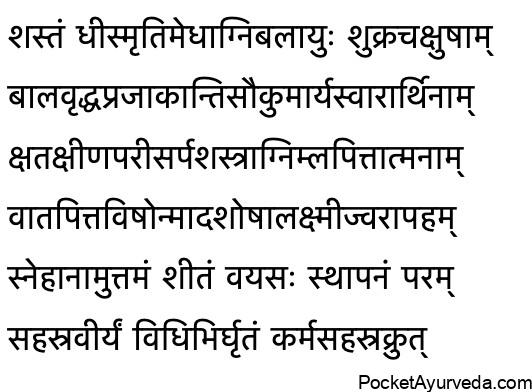

Ghee Benefits according to ayurveda
1. improving intelligence;
2. memory,
3. ingenuity,
4. digestion strength,
5. long life,
6. semen (sexual vigour), and
7. eye sight.
8. is good for children,
9. the aged,
10. those who desire more children,
11. tenderness of the body, and
12. pleasant voice,
13. for those suffering from emaciation as a result of injury to chest (lungs),
14. Parisarpa (herpes),
15. injury from weapons, and fire,
16. disorders of Vata and Pitta origin,
17. poison,
18. insanity,
19. inauspicious activity (witchcraft, etc.) and
20. fevers;
Of all the fatty materials, ghee is the best.
a.It is coolant,
b.best for retaining youth;
c.capable of giving a thousand good effects by a thousand kinds of processing.
PURANA GHRITA – OLD GHEE


Purana Ghrita (old ghee) is used in the treatment of
1. Mada – intoxication,
2. Apasmara – epilepsy,
3. Murcha – fainting,
4. Shira, karna, akshi yoni roga – diseases of the head, ear, eye and vagina;
5. cleanses and heals wounds.
MILK PREPARATIONS, FATTY DAIRY PRODUCTS


Kilata, Piyusa, Kurcika, Morana, etc. are
1. strengthening,
2. increase the semen,
3. sleep and
4. Kapha,
5. cause constipation,
6. heavy to digest,
7. and aggravate the Doshas.
Notes –
· Kilata is the solid portion obtained after heating curds or buttermilk,
· Piyusa is the milk of a cow that has just given birth to a calf, upto a period of about three days or till the milk becomes thin;
· Kurcika is the solid portion obtained after heating buttermilk
· while Morana (or Morata) is the sour, thin liquid portion.


Milk and ghee obtained from cow’s milk are best and those obtained from sheep’s milk, the least.
IKSU VARGA – GROUP OF SUGARCANE JUICE AND ITS PRODUCTS
Iksurasa Guna – properties of sugarcane juice
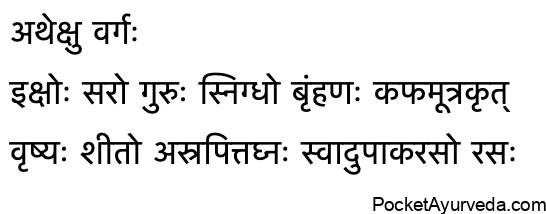

Sugar cane Juice qualities
1. Sara (laxative),
2. Guru – heavy to digestion
3. Snigdha – unctuous
4. Brihmana – nutritive, improves weight
5. Kaphakrut – increases Kapha
6. Mutrakrut – increases urine volume
7. Vrushya – aphrodisiac
8. Sheeta – coolant
9. Asrapittaghna – useful in bleeding disorders
10. Swadupaka rasa – sweet.
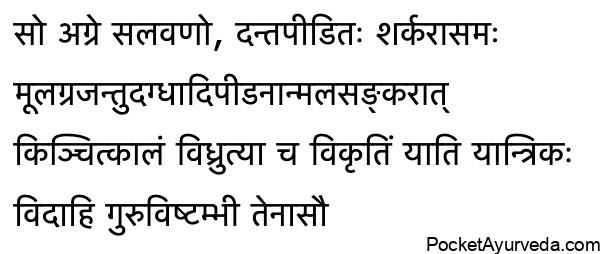

· The tip of shoots of sugarcane has salt taste. If the roots, shoots and worm infested parts of the cane is crushed together, the juice gets mixed with dirty material. It leads to burning sensation, indigestion and constipation.
Sugar cane best varieties


The Poundraka variety of cane is best in view of the coolant, effect, thinness, and sweetness of its juice; next to it is the Vamsika variety.


Next are the Sataparvaka, Kantara, Naipala, etc., in respective order,
· are slightly Alkaline and astringent in taste,
· hot in potency and
· cause a burning sensation slightly.
PHANITA – HALF COOKED MOLASSES, UNREFINED TREACLE


Phanita Qualities – half cooked molasses
· is heavy (hard to digest),
· Abhisyandi (increasing the secretions in the pores of the tissue and blocking them),
· causes a mild increase of Tridosha and
· Cleanses the urine (by increasing its quantity).
GUDA – JAGGERY / MOLASSES / TREACLE


Guda – jaggery, molasses, washed well – made white and purified
1. Natishleshma kara – does not increase Kapha to a large extent
2. Srushtamutrashakrut – increases the volume of urine and feces
If Jaggery not prepared properly,
a. it causes intestinal worms.
b. increases chances of Kapha disorder in the marrow, blood, fat tissue, and muscles.


· Old jaggery uses
is good for the heart, and should be consumed.
· Freshly prepared jaggery
increases Kapha and causes indigestion.
MATSYANDIKAADI – Sugar


a. Matsyandika (brown sugar),
b. Khanda (sugar candy) and
c. Sita (white crystalline sugar) in their succeeding order are better.
· They are aphrodisiac, good for the emaciated and the wounded, useful in bleeding diseases and aggravation of Vata.
YASA SARKARA – SUGAR PREPARED FROM YAVASAKA PLANT


· is similar in properties to sugar
· but is bitter-sweet and astringent in taste.


· All types of sugars are useful in burning sensation, thirst, vomiting, fainting and bleeding diseases.


· Among the products of sugarcane juice, sugar is the best and Phanita (half cooked molasses) is the least.
MADHU – HONEY :-
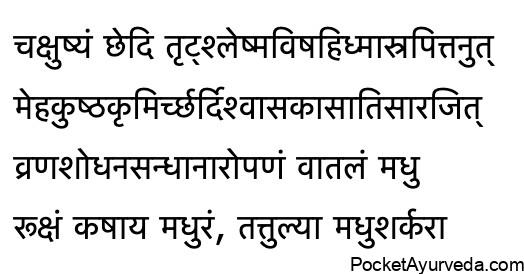

Madhu – honey qualities
· Chakshushya – good for the eyes (vision),
· Chedi – breaks up hard masses,
· Trut – relieves thirst,
· Shelshmahara – balances Kapha
Honey uses in diseases
- Visha – toxicity
- Hidhma – hiccup
- Asrapitta – bleeding conditions
- Meha – diabetes, urinary tract diseases
- Kushta – skin diseases
- Krumi – worm infestation
- Chardi – vomiting
- Shwasa – dyspnoea, chronic respiratory diseases
- Kasa – cough, cold
- Atisara – diarrhea
- Vrana shodhana – cleanses wounds
- Vrana sandhana, ropana – heals wound quickly
- Vatala – increases Vata
- Ruksha – dry
- Kashaya, Madhura – astringent and sweet
Madhu Sarkara
· Crystallized honey – Madhu Sarkara is similar to honey in properties.


Honey Kills if consumed hot
· Honey, kills, if used after heating it, and by those suffering from great heat, used during hot season, hot country or with hot foods.
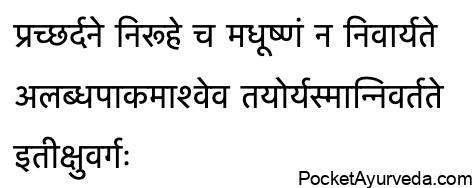

· But honey does not cause any harm when used warm for producing vomiting or for administration of Niruha (decoction enema) (Vamana & Basti) because it comes out of the body before it undergoes digestion.
TAILA VARGA – GROUP OF OILS AND OTHER FATS :-


· Oils are generally similar to their source (oil seed).
· Sesame oil is the most important among all oils.
Sesame oil uses – Tila Taila Uses
a.Tvak doshanut – cleanses and detoxifies skin
b.Chakshushya – good for eyes
c. Sukshma – pierces into deep tissues
d. Ushna – hot,
e. balances Kapha f. for both obese and emaciated people.
g.Useful to relieve constipation and worm infestation.
· When it is processed with other herbs, it is very beneficial in various diseases.
OIL OF ERANDA – CASTOR OIL BENEFITS
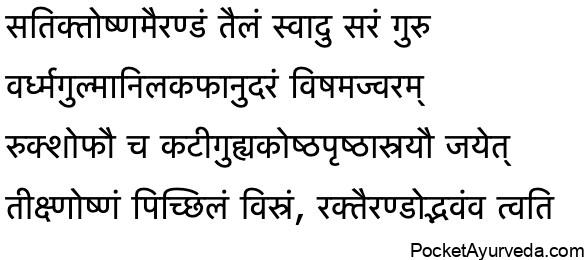

Castor oil qualities
- is bitter, pungent and sweet in taste,
- Sara – promotes the natural movement of body fluids (laxative),
- Guru – hard to digest,
useful in
- Vardhma – enlargement of the scrotum (hernia),
- Gulma – abdominal tumors,
- Anila kaphahara – diseases caused by Vata and Kapha,
- Udara – ascites
- Vishama jwara – intermittent fevers,
- pain and swellings of the waist, genitals, abdomen, and back,
- is capable of penetrating deep,
- hot in potency and
- bad in smell.
· Oil of red variety of castor seeds is still more penetrating, hot in potency, and sticky, and has a bad smell.
Notes :-
Castor oil is used for medicinal purposes to produce purgation to relieve pains and reduce swelling etc. it is an efficient Vatahara drug (mitigates the increased Vata) and so very useful in many diseases.
SARSHAPA TAILA – MUSTARD OIL harms


Sarsapa Taila – mustard oil harms
· pungent, hot in potency, penetrating deep, mitigates (reduces) Kapha, semen and Anila (Vata), easy to digest, causes bleeding diseases, rashes on the skin, skin diseases, hemorrhoids, ulcers, and worms (bacteria, etc).
AKSHA TAILA – OIL OF VIBHITAKA


Aksa Taila – oil obtained from seeds of Vibhitaka
· is sweet, cold in potency good for the hair, hard to digest, and mitigates Pitta and Vata.
NIMBA TAILA – NEEM OIL


· Neem oil – is not very hot (slightly hot) in potency, bitter, anti-microbial, useful in skin diseases, and mitigates Kapha.
Uma-Kusumbha Taila – inseed oil and safflower oil


· Taila of Uma (linseed) and Kusumbha are hot in potency, produce diseases of the skin, aggravate Kapha and Pitta.
VASA-MAJJA-MEDAS – MUSCLE-FAT, MARROW AND FAT


· Vasa (muscle-fat) and Majja (bone marrow) and fat mitigate Vata, cause increase of strength, Pitta and Kapha and similar in properties to the meat of animals from which they are obtained.
MADYA VARGA – GROUP OF WINES
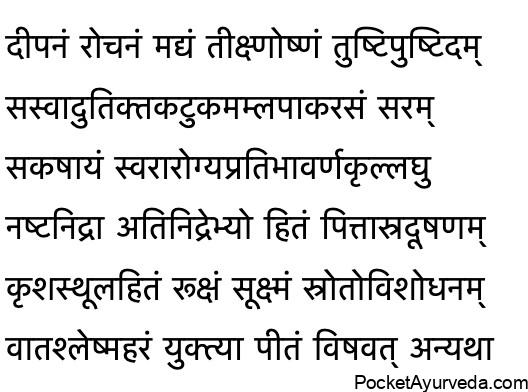

Madya – wines, all alcoholic beverages Qualities and benefits in Ayurveda
1. Deepana – stimulate digestion,
2. Rochana – help taste,
3. Teekshna – penetrate deep,
4. Ushna – hot in potency,
5. Tushti pushtida – give satisfaction and nourishment
6. Sasvadu tikta katukam – slightly sweet, bitter and pungent in taste,
7. Amlapaka rasa – sour at taste and at the end of digestion,
8. Sara – laxative,
9. Sakashaya – slightly astringent,
10. Svara – confer good voice,
11. Arogya – improves health,
12. Pratibha – talent,
13. Varna – colour and complexion;
14. Laghu – easy to digest,
· Beneficial to those having loss of sleep or excess sleep for both lean and stout persons;
· is non-viscid,
· capable of entering through minute pores and cleansing them,
· mitigate Vata and Kapha,
· all these if used judiciously;
· but used otherwise, they act like poison.
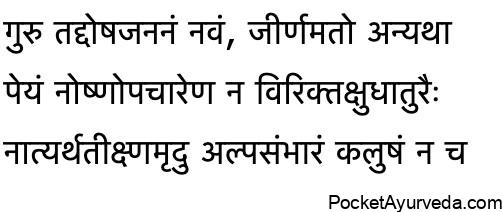

Fresh wine
· is hard to digest; increases of all the Doshas, whereas old ones decrease;
Contraindication for wines:
1. Wine should not be consumed hot.
2. It should not be consumed by the person undergoing Virechana (purgation) panchakarma therapy
3. It should be avoided by hungry person
· Wines that are very strong or very weak, which are very clear (like water) or very turbid and those which are spoilt, should not be used for drinking.
SURA – BEER Uses in Ayurveda


· Sura is useful in abdominal tumors, enlargement of the abdomen, heamorrhoids, duodenal diseases, is lubricating, hard to digest, mitigates Vata, causes increase of fat, blood, milk, urine and Kapha.
Notes:-
· Sura is prepared by fermenting a mixture of water, flour of rice, jaggery (treacle), etc., somewhat like the beer of the present day.
VIBHITAKA SURA
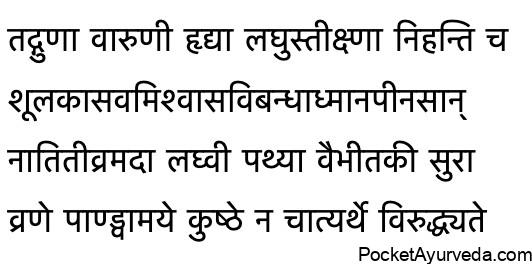

Sura prepared from Vibhitaka is not very intoxicating, is easy to digest, good for health; not so harmful, (as other wines) in wounds, anaemia, and leprosy and other skin diseases.
YAVA SURA


Sura prepared from Yava – Barley – Hordeum vulgare (barley)
causes constipation, is difficult to digest, non-unctous and aggravates all the three Doshas.
ARISTA – FERMENTED DECOCTIONS
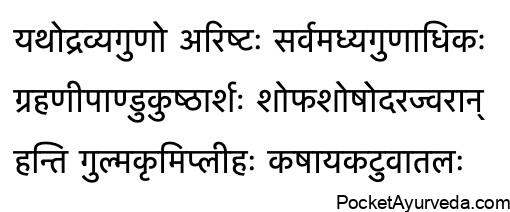

Arista – fermented decoctions uses and benefits
· possess properties of the materials from which it is prepared, and
· is more intoxicating of all alcoholic beverages;
· it is useful in disease of the duodenum, anaemia, skin diseases, haemorrhoids, dropsy, enlargement of the abdomen, fever, abdominal tumors, worms (intestinal parasites) and disorders of the spleen; is astringent, pungent and aggravates Vata
WINE PREPARED FROM GRAPES – MARDVIKA


wine prepared from grapes qualities – Mardvika Guna
· is scraping, good to the heart, not very hot in potentcy, sweet,
Sara – promotes natural movement of body fluids (laxative), causes slight increase of Pitta and Anila (Vata), useful in anaemia, diabetes, hemorrhoids and worms (intestinal parasites).
wine prepared from dates – Kharjura


· is inferior in properties than grapes, aggravates Vata, and is hard for digestion.
WINE PREPARED BY USING SUGAR – SARKARA


· Is sweet smelling, sweet in taste, good for the heart, not very intoxicating, and easy to digest.
Wine prepared by using molasses/treacle – Gouda


· Increases volume of urine, faeces and flatus, is nourishing and increasing hunger.
WINE prepared from SUGARCANE JUICE – SIDHU
Sidhu – prepared from fermenting sugarcane juice


· aggravates Vata and Pitta, decreases lubrication and diseases of Kapha, obesity, dropsy, enlargement of the abdomen and hemorrhoids; prepared by cooking sugarcane juice is best.
WINE PREPARED FROM HONEY – MADHVASVA


Madhwasava (wine prepared from honey)
· breaks up hard masses (of Kapha etc), penetrates deep, useful in diabetes, chronic nasal catarract, and cough.
WINE PREPARED FROM TUBERS – SUKTA
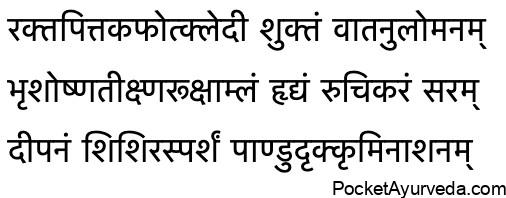

Sukta (wine prepared from roots and tubers)
· increases the moisture of blood, Pitta and Kapha, expels Vata in downward directions, very hot in potency, is penetrating, causes dryness, sour, good to the heart, increases taste (appetite), is Sara – promotes bowel movements (laxative), enhances hunger, is cold to touch, useful in anemia, diseases of the eye and worms.
· Sukta prepared by using jaggery, sugarcane, honey, and grapes are easy to digest in their successive order.
Ritucharya adhyaya ऋतुचर्या Seasonal Regimen : Ashtanga Hridayam Chapter 3
ASAVA – FERMENTED INFUSION


· Asava prepared by using tubers, roots, fruits, etc, is similar to shukta.


· Asava prepared by using Sandaki (balls of fried paddy mixed with spices, dried in sun and then deep fried in oil) and by other material (such as oil-cakes etc) which have turned sour by lapse of time are appetizers and are easy to digest.
DHANYAMLA (liquor prepared by fermenting the water in which rice and such other grains, pulses etc. have been slightly cooked or merely washed) :-
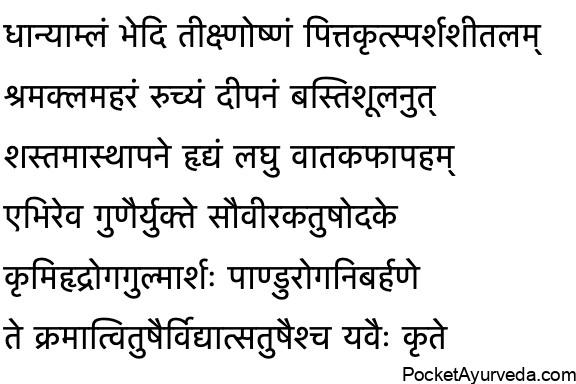

Dhanyamla (liquor prepared by fermenting the water in which rice and such other grains, pulses, etc. have been slightly cooked or merely washed)
· is purgative, penetrating, hot in potency, aggravates Pitta, cold to touch, relieves fatigue and exhaustion, increases appetite and hunger, useful in pain of the urinary bladder, ideal for use as Asthapana (decoction enema), good to the heart, easy to digest, balances Vata and Kapha.
· Sauviraka and Tushodaka also possess similar properties,
· useful in worms, heart disease, abdominal tumors, hemorrhoids, and anemia.
· These are prepared from dehusked barley and barley-with-husk.
Notes :-
· Shukta – Fermented gruel, Dhanyamla, Sauviraka, Tushodaka etc. were in use since ancient times.
· But now a days beer brandy etc. alcoholic beverages have replaced them.
MUTRA VARGA – GROUP OF URINE
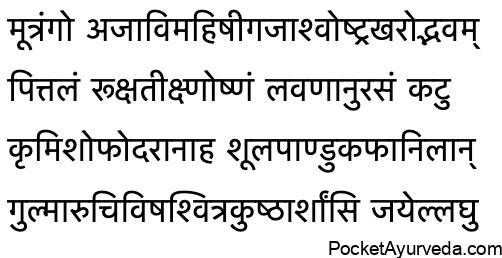

Urine of cow, goat, sheep, buffalo, elephant, horse, camel and donkey –
· these aggravate Pitta, are non-unctous, penetrating deep, hot in potency, pungent with salt as its secondary taste and useful in worms, dropsy, abdominal enlargement, flatulence, colic, anemia, aggravation of Kapha and Vata, abdominal tumors, loss of taste, poisoning, leucoderma, skin diseases and piles, and are easy to digest.
तोयक्षीरेक्षुतैलानां वर्गैर्मध्यस्य च क्रमात्
इति द्रवैकदेशो अय यथास्थूलमुदाह्रतः
FAQ’S of DravaDravya Varga Chapter 5
- What are the benefits of drinking rainwater?
Jeevaneeya,Tarpana,Hrudya,Hladi,Buddhi prabodhanam,Tanu,Avyaktarasa,sheeta,laghu,amrutopama
- How to test water quality
Only that rainwater which makes the boiled rice kept in a clean silver plate neither too moist nor change its color is to consider as good for drinking.
- When one can consume SEA WATER?
Seawater should not be used for drinking expect during Ashvayuja month. (September. October/autumn season).
- Which Water should be consumed?
Rainwater, collected in a clean vessels and which has not changed in color, taste, and odor should be used for drinking always.
- What are the benefits of river water?
Rivers of Arabian sea water is sweet,pure,healthy and rivers of eastern ocean should not be consumed
- When to drink water with food?
Drinking water in between meals – a healthy habit.
- what happen if you drink water before meal?
Drinking water before meals – causes emaciation, weakness
- what happen if you drink water after meal?
Drinking water after meals – causes obesity
- When to drink cold water?
1. Madatyaya – alcoholic intoxication,
2. Glani – exhaustion,
3. Murcha – fainting,
4. Chardi – vomiting,
5. Shrama – debility (fatigue),
6. Bhrama – dizziness, giddiness,
7. Trushna – thirst,
8. Ushna – heat (of the sun) burning sensation,
9. Pittasra – bleeding conditions and Pitta dominant conditions
10. and Visha – poison. - What are the Health benefits of DRINKING HOT WATER?
1. Deepana – stimulates hunger,
2. Pachana – helps digestion,
3. Kantya – good for the throat,
4. Laghu – easily to digest,
5. Basti shodhana – cleanses the urinary bladder,
Relieves
6. Hidhma – relives hiccup,
7. Adhmana – flatulence,
8. Anila – aggravation of Vata
9. Shleshma – aggravation of Kapha
10. It is ideal on the days of Panchakarma therapy
11.Navajvara – fever of recent origin
12. Kasa – cold, cough
13. Ama – accumulation of undigested materials,
14. Peenasa – rhinitis (running nose),
15. Shwasa – dyspnoea and
16. Parshvaruja – pain in the flanks - what happen if you consume water which is boiled and then cooled
a. Anabhishyandi – does not increase moisture or stickiness in the body
b. Laghu – light to digest
c. Useful in Pitta conditions - water kept for over night is healthy?
No. it increases tridosha
- What are the health benefits of COCONUT WATER – NARIKELODAKA
Tender coconut water is
1. Snigdha
2. Swadu – sweet,
3. Vrushya – aphrodisiac,
4. Hima – coolant,
5. Laghu – easy to digest
Relieves
a. Trushna – thirst,
b. Pittanila hara – balances Pitta and Vata.
c. Deepana – increases hunger and
d. Bastishodhana – cleanses urinary bladder. - Which water should be consumed during rainy season?
a. rainwater is best and
b. river water least suitable for consumption. - what are the Qualities of milk?
1. Svadupakarasa – sweet in taste and also at the end of digestion,
2. Snigdha – unctuous,
3. Ojovardhana – increases Ojus,
4. Dhatuvardhana – nourishes and increases body tissues,
5. Vata Pittahara – mitigates Vata and Pitta,
6. Vrushya – aphrodisiac,
7. Shleshmala – increases kapha
8. Guru – heavy to digest
9. Sheetala – coolant - what are the qualities of cow’s milk?
1. Jeevaneeya – promotes long life,
2. Rasayana – anti aging, rejuvenating
3. Kshataksheena hita – good for those emaciated after chest injury
4. Medhya – increases intelligence,
5. Balya – strengthening
6. Stanyakara – promotes breast milk production
7. Sara – helps easy movement of the bowels - cows milk is helpful in which diseases?
a. Shramahara – exhaustion,
b. Bhramahara – dizziness
c. Mada – toxicity,
d. Alakshmi – in-auspiciousness
e. Shwasa – dyspnoea,
f. Kasa – cough,
g. Atitrut Kshudha – severe thirst and hunger,
h. Jeernajvara – chronic fevers,
i. Mutrakrichra – dysuria
j. Raktapitta – bleeding diseases - What are the health benefits of consuming buffalo milk?
Collant, helps in insomnia, good for people with good digestion power
- What are the health benefits of consuming goat milk?
1. Shosha – emaciation
2. Jvara – fever
3. Shwasa – dyspnoea, asthma, chronic bronchial disorders
4. Raktapitta – bleeding disorders of Pitta origin such as hemorrhoids, nasal bleeding
5. Atisara – diarrhoea, dysentery. - what are the qualities of camel milk?
1. Ishat ruksha – slightly dry
2. ushna – hot
3. Lavana – salty taste
4. Deepana – increases digestion strength
5. Laghu – easy to digest
6. Vatakaphaan shastam – useful in Vata and Kapha
7. Krumi – relieves worm infestation
8. Shopha – anti inflammatory
9. Udara – useful in ascites
10. Arshas – haemorrhoids. - What are the benefits of breast milk?
1. Vata and Pitta imbalance disorders
2. Asruk – blood vitiation disorder
3. Abhighata – useful in injuries
4. Akshirooga – it is used as an eye drops to relieve eye infections and to relieve redness. - is sheep milk is good for health?
1. is not good for heart,
2. hot in nature,
3. useful in Vata disorders,
4. gives rise to hiccup,
5. respiratory conditions.
6. It increases Pitta and Kapha. - What are the benefits of ELEPHANT MILK – HASTIKSHEERA
It is strengthening in nature.
- is uncooked milk healthy?
No, Uncooked milk is always harmful
- what are the health benefits of curd?
aruchau – useful in anorexia
· Vishamajwara – chronic, recurrent fever
· Peenasa – rhinitis
· Mutrakruchra – dysuria
· Grahani – malabsorption syndrome - what are the rules of curd as per ayurveda?
Curd should not be eaten at night,
b. Not made hot,
c. Curd should not be taken along with green gram soup
d. It should not be taken along with honey, ghee, sugar, and Amla.
e. It should not be taken daily. - what are the qualities of curd?
1. Amla rasa – sour taste
2. Amla paka – undergoes sour taste conversion after digestion
3. Grahi – absorbent, useful in diarrhea,
4. Guru – heavy to digest
5. Ushna – hot in nature
6. Vatajit – balances Vata - curd is helpful in which situations?
Increases
· Meda (fat),
· Shukra (semen),
· Bala (strength),
· Kapha,
· Raktapitta (bleeding disorders),
· Agni (digestion strength) and
· shotha (inflammation).
Rochishnu – increases the taste - What happens when you consume curd daily ?
It may cause/worsen fever,
· bleeding disorders,
· skin diseases,
· anemia and
· dizziness. - what are the qualities of Takra (butter milk) – churned curds
1. Laghu – easy to digest
2. Kashaya, amla – sour, astringent,
3. Deepana – improves digestion strength
4. Kaphavatajit – balances Kapha and Vata - what are the uses and benefits of takra?
a. Shopha – inflammatory conditions
b. Udara – ascites
c. Arsha – haemorrhoids
d. Grahani – malabsorption syndrome
e. Mutradosha, Mutragraha – urine infection, dysuria
f. Aruchi – anorexia
g. Pleeha – splenomegaly
h. Gulma – abdominal distention
i. Ghritavyapat – in indigestion caused by excess consumption of ghee
j. Gara visha – chronic intoxication and
k. Pandu – anemia - what are the qualities of mastu?
· Sara – promotes movement of fluids inside body channels
· Srotashodhi – cleanses body channels
· Vishtambhajit – relieves constipation
· Laghu – easy to digest. - what are the qualties of fresh butter?
1. Vrushya – aphrodisiac,
2. Sheeta – coolant
3. Varna, bala, agnikrut – improves skin complexion, strength and digestion strength.
4. Sangrahi – abosrbent, useful in diarrhoea
5. Vatapittasruk jit – balances Vata, Pitta and detoxifies blood - what are the uses and benefits of butter?
a. Kshaya – chronic respiratory disorders leading to emaciation
b. Arsha – hemorrhoids
c. Ardita vata – paralysis
d. Kasa – cough - What are the health benefits of good quality butter?
i. Sangrahi – absorbent, useful in diarrhoea
ii. Raktapittajit – useful in bleeding disorders
iii. Akshirogajit – useful in eye diseases. - what are the Ghee Benefits according to ayurveda?
1. improving intelligence;
2. memory,
3. ingenuity,
4. digestion strength,
5. long life,
6. semen (sexual vigour), and
7. eye sight.
8. is good for children,
9. the aged,
10. those who desire more children,
11. tenderness of the body, and
12. pleasant voice,
13. for those suffering from emaciation as a result of injury to chest (lungs),
14. Parisarpa (herpes),
15. injury from weapons, and fire,
16. disorders of Vata and Pitta origin,
17. poison,
18. insanity,
19. inauspicious activity (witchcraft, etc.) and
20. fevers; - what are the health benefits of consuming ghee daily?
It is coolant,
best for retaining youth;
capable of giving a thousand good effects by a thousand kinds of processing. - what are the health benefits of purana ghrita old ghee?
1. Mada – intoxication,
2. Apasmara – epilepsy,
3. Murcha – fainting,
4. Shira, karna, akshi yoni roga – diseases of the head, ear, eye and vagina;
5. cleanses and heals wounds. - which are the qualities of sugar cane juice?
1. Sara (laxative),
2. Guru – heavy to digestion
3. Snigdha – unctuous
4. Brihmana – nutritive, improves weight
5. Kaphakrut – increases Kapha
6. Mutrakrut – increases urine volume
7. Vrushya – aphrodisiac
8. Sheeta – coolant
9. Asrapittaghna – useful in bleeding disorders
10. Swadupaka rasa – sweet. - which is the best wine according to ayurveda?
wine made from grapes.


